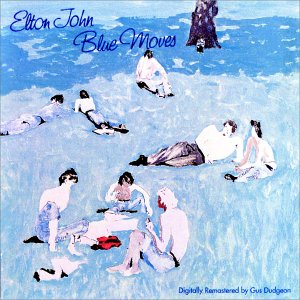This is the second half of the review; make sure to read the introduction before going on.
As good as “One Horse Town” is, the song is a lone exponent of loud music within the two records that make up “Blue Moves”. “Tonight” gives you an exact idea of the kind of compositions that define the disc, and it markedly highlights the somberness I mentioned in the first part of the review. It is not that Elton did never cut something somber before – “Goodbye Yellow Brick Road” dealt with its fair share of touchy issues. But the instrumentation steered everything into a more joyous destination. The opposite can be said about “Blue Moves”.
And maybe one of the clearest examples of the contrast between the two double albums (they have to be contrasted – they were the only Elton ever issued) is found in the eulogies that are featured. “Goodbye Yellow Brick Road” had “Candle In The Wind”, and “Blue Moves” had “Cage The Songbird”. “Candle In The Wind” was for Marilyn Monroe. “Cage The Songbird” was for Edith Piaf. The first was lush and elegant instrumentally, the second was contrite and subdued, and were it not for Graham Cosby and Steve Nash’s harmonies it would even have been drab. Of course, “Candle In The Wind” was a lyric Elton had not a lot to refer to, not especially when placed against something like“Cage The Songbird”. The song dealt with Marilyn Monroe, and it focused on the price paid by those enslaved by showbiz. The perspective was 100 % Bernie, and if it had something to do with Elton, it had to do with the outward image he projected, and how the media used that persona to fabricate what it wished. “Cage The Songbird”, on the other hand, dealt with the passing of a master songstress. It wasn’t that difficult for Elton to get introspective at all.
Crosby and Nash also sing backup on “The Wide-Eyed And Laughing”, the one true curveball of the whole album, and a clear standout track both for Caleb and Davey. They play 12-string guitar and sitar respectively, laying the foundation for a Eastern-derived song which reminds us of the willingness to experiment that was at the core of everything that Elton did during his classic years. That was sadly being displaced further and further until it was too late to put in back into position.
And two tracks are graced by the Beach Boys singing backup, too, and much like “Don’t Let The Sun Go Down On Me” on “Caribou” these songs were to be refined and defined by their contributions. They are “Chameleon” (a song that was actually offered to them by Elton; they turned it down but agreed to sing on his own version of the song), and “Someone’s Final Song” , a valedictory tune where Bernie sounds jaded like never before – he was actually going to take a few years off after “Blue Moves”. The harmonized coda puts a fine (if utterly eerie) point to it all. Continue reading

